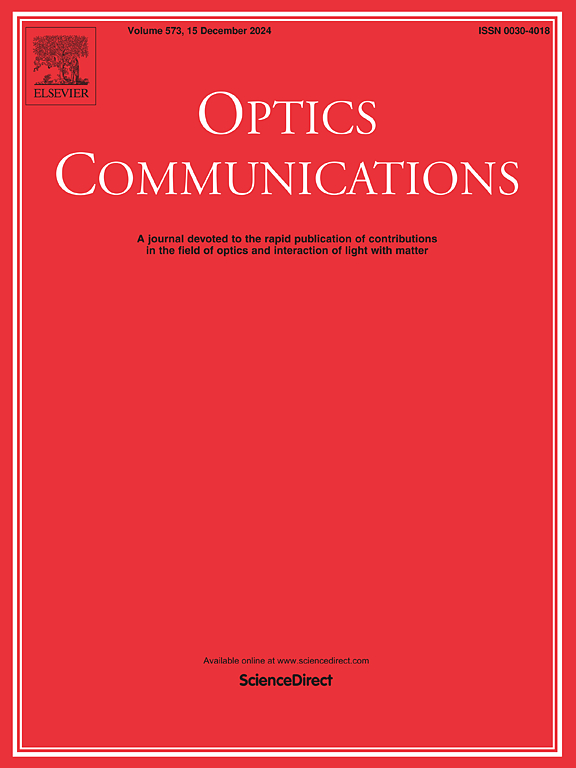RECNN: Restoration and extraction of incomplete brillouin gain spectrum based on CNN framework combined with SVAE and attention mechanism
IF 2.2
3区 物理与天体物理
Q2 OPTICS
引用次数: 0
Abstract
In this paper, we propose a novel method under convolutional neural network framework combined with a supervised variational autoencoder and an attention mechanism, named the Restoration and Extraction Convolutional Neural Network (RECNN), for the restoration and extraction of Incomplete Brillouin Gain Spectrum (IBGS). It is important to clarify that the IBGS discussed here does not encompass information around the Brillouin Frequency Shift (BFS). This omission complicates the task of reconstructing the original spectrum or determining the BFS value. The RECNN framework consists of two main components: Restoration Supervised Variational Autoencoder (RSVAE) with an attention module for IBGS restoration, and Residual Attention Convolutional Neural Network (RACNN) for BFS extraction. Different types of IBGS are discussed in detail. We define the K index to quantify the incompleteness of the IBGS and introduce the R-squared index to measure the restoration performance of RSVAE. Additionally, the Root Mean Square Error (RMSE) and uncertainty are used to evaluate the overall performance of RECNN. Both simulation and experimental results demonstrate that the R-squared index increases with increasing K and Signal-to-Noise Ratio (SNR), while both RMSE and uncertainty decrease with increasing K and SNR. In comparisons with various other methods including Linear Curve Fitting (LCF) and artificial neural networks, RECNN consistently outperforms them. Specifically, simulation results show that when K is 0.5 and SNR is 4 dB, the R-squared value for RSVAE reaches 0.82, significantly higher than the 0.31 achieved by LCF method. Experimental results indicate that for an SNR of 6.78 dB and K of 0.5, the RMSE and uncertainty of RECNN are 3.21 MHz and 2.68 MHz, respectively, representing reductions of 11.43 MHz and 11.17 MHz compared to LCF. It's noteworthy that the time consumption evaluation indicates that RECNN requires less than 7 ms to restore the complete BGS and obtain the BFS value. These results are consistently observed in both simulations and experimental studies, which bodes well for the future of extracting valuable latent information from outdated and corrupted data stored in databases of distributed fiber sensing applications.
RECNN:基于CNN框架结合SVAE和注意机制的不完全布里渊增益谱恢复与提取
本文在卷积神经网络框架下,结合有监督变分自编码器和注意机制,提出了一种恢复与提取卷积神经网络(RECNN),用于恢复与提取不完全布里温增益谱(IBGS)。重要的是要澄清,这里讨论的IBGS不包括布里渊频移(BFS)周围的信息。这种遗漏使重建原始光谱或确定BFS值的任务变得复杂。RECNN框架由两个主要部分组成:用于IBGS恢复的带有注意模块的恢复监督变分自编码器(RSVAE)和用于BFS提取的残差注意卷积神经网络(RACNN)。详细讨论了不同类型的IBGS。我们定义了K指数来量化IBGS的不完备性,并引入r平方指数来衡量RSVAE的恢复性能。此外,使用均方根误差(RMSE)和不确定性来评估RECNN的整体性能。仿真和实验结果均表明,r平方指数随K值和信噪比的增大而增大,均方根误差和不确定性随K值和信噪比的增大而减小。在与线性曲线拟合(LCF)和人工神经网络等各种方法的比较中,RECNN始终优于它们。具体而言,仿真结果表明,当K为0.5,信噪比为4 dB时,RSVAE的r平方值达到0.82,显著高于LCF方法的0.31。实验结果表明,在信噪比为6.78 dB、K为0.5的情况下,RECNN的RMSE和不确定度分别为3.21 MHz和2.68 MHz,比LCF降低了11.43 MHz和11.17 MHz。值得注意的是,时间消耗评估表明,RECNN恢复完整的BGS并获得BFS值所需的时间小于7 ms。这些结果在模拟和实验研究中都得到了一致的观察,这预示着从分布式光纤传感应用数据库中存储的过时和损坏数据中提取有价值的潜在信息的未来。
本文章由计算机程序翻译,如有差异,请以英文原文为准。
求助全文
约1分钟内获得全文
求助全文
来源期刊

Optics Communications
物理-光学
CiteScore
5.10
自引率
8.30%
发文量
681
审稿时长
38 days
期刊介绍:
Optics Communications invites original and timely contributions containing new results in various fields of optics and photonics. The journal considers theoretical and experimental research in areas ranging from the fundamental properties of light to technological applications. Topics covered include classical and quantum optics, optical physics and light-matter interactions, lasers, imaging, guided-wave optics and optical information processing. Manuscripts should offer clear evidence of novelty and significance. Papers concentrating on mathematical and computational issues, with limited connection to optics, are not suitable for publication in the Journal. Similarly, small technical advances, or papers concerned only with engineering applications or issues of materials science fall outside the journal scope.
 求助内容:
求助内容: 应助结果提醒方式:
应助结果提醒方式:


